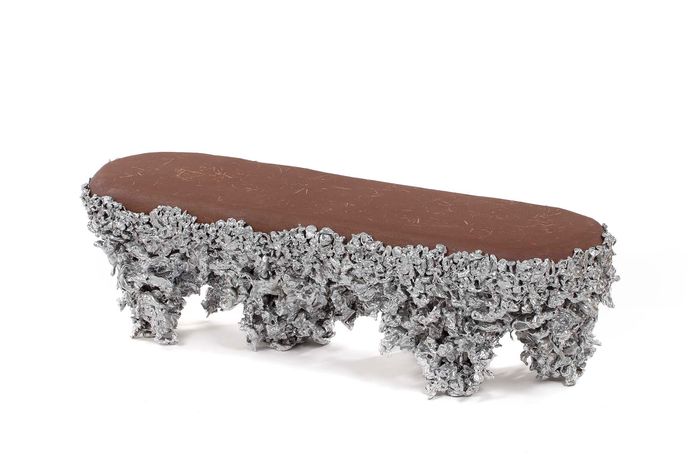
With spring just a few weeks away, galleries and showrooms are returning from winter break, some in new, spacious venues. Plus a few newcomers, like Salon 21, are trying to bring back a living-room-style approach to exhibitions and programming. We’ll be here monthly with more updates as designers get ready for April’s Salone in Milan and NYCxDesign in May.
In a new Superhouse space, Paa Joe’s fantasy coffins
Stephen Markos’s design gallery, Superhouse, previously located on the second floor of the Chinatown mini-mall at 75 East Broadway, has migrated about five blocks westward to 120 Walker Street. With the move came significant space — about 15 times more. The 1,500-square-foot venue will open on March 15 with a solo exhibition by Ghanaian artist and craftsman Paa Joe, known for his carved wooden coffins, or abeduu adekai, funerary sculptures that seek to represent the lives of the dead. “Celestial City,” Joe’s debut New York show, will pay homage to the Big Apple with a human-scale coffin in the shape of a yellow cab and mini-replicas of the Guggenheim Museum and the Statue of Liberty alongside other NYC iconography. Through April 26.
Salon 21: Marc Armitano Domingo
Walking into Salon 21’s sun-soaked Soho loft, one gets the impression of a vintage collector’s studio or an artist’s living space. Salon 21 takes a more domestic approach to its showroom (think Gertrude Stein’s Parisian gatherings) with its camel-tone beige walls and ’70s-era modular sofa positioned to create a conversation pit. Founded and curated by Alex Bass, the space hosts near-weekly cultural events that are open to the public (March will feature a book club, a catered dinner party, and an Orson Welles film screening) in addition to rotating monthly exhibitions of emerging artists and designers, viewable by appointment.
Visitors can see Marc Armitango Domingo’s exquisite porcelain plates, trays, vessels, and oil paintings through March 9. His gold-accented insect plates, inspired by 16th-century French potter Bernard Palissy, and hand-painted “lampe de nuit” candlesticks are objects of functional whimsy. The lamp contains a wide brim to catch candle-wax drippings and a deep base to hold water, which keeps the candle afloat as it burns. Similarly, his porcelain flower bricks are designed to hold cut flowers that can be easily watered. It’s “art that can be lived with,” to quote Bass’s mission for Salon 21, and casually handled. If not for the gold accents, Domingo joked, the ceramics would be dishwasher friendly. Through March 9.
The New York outpost of Silencio
The Parisian nightclub Silencio — its namesake a dilapidated fictional venue in David Lynch’s Mulholland Drive — recently opened a Manhattan outpost. Here, the mood is more Old Hollywood glamour than ominous and perplexing, as Lynch’s movies tend to be. The entrance through a grungy stairwell may be the most foreboding element of the space. Inside, the red drapes elegantly curtain off the VIP booths, mini-rooms encased in a reflective gold sheen, from the rest of the dance floor.
Lynch, who was deeply involved with the French club’s opening, isn’t at all affiliated with the New York branch, though his name is often invoked. There are no low, curved walls in New York’s Silencio, unlike the French club, which looks like a gilded den. Instead, the designer, Harry Nuriev of Crosby Studios, maintained an element of Lynch’s influence through red and gold tones, colors also popular among upscale Manhattan lounges where cocktails commonly go for $30 a pop. (A visitor recently complained about the price of Silencio’s drinks on Twitter but conceded that the interior design was worth the visit.) But it’s the monochromatic rooms and space-age-style furnishings, juxtaposed against the plush walls and textures, that distinguish Silencio from other lounges: The space feels more like a boudoir than a club. There is nothing Lynchian about Silencio, which may be a good thing.
Estúdio Campana at Friedman Benda
For the Brazilian studio’s fifth solo show at Friedman Benda, Estúdio Campana returns on March 7 with “On the Road,” the first exhibition solely designed by Humberto Campana after the death of his brother and partner, Fernando, in 2022. Campana presents a new collection highlighting local materials, such as a buffet made of jequitibá wood and a chair spun from gold-tone fibers from Brazil’s Jalapão region, alongside objects crafted from adobe and aluminum scraps in a striking assemblage of hybrid textures and shapes. Iterations of older works, like the bronze-cast-rope Ofidia lamps and the Branches bench (which recalls the 2017 Branches sofa), are a nod to the studio’s 40-year legacy and Campana’s desire to reconnect with nature and Brazilian craft traditions. Through April 20.
A Vintage Furniture Store Expands: Renew Finds


Greenpoint-based vintage-furniture store Renew Finds has reopened its 2,600-square-foot showroom after a brief winter break, migrating from its previous 67 West Street location to 80 Oak Street, and is open for walk-ins on weekends. The space is available for rental throughout the week, as is all of its furniture. The collection of rental-only vintage goods includes iconic Memphis pieces like a First Chair by Michele De Lucchi and a Tahiti table lamp along with playful classics like a Gaetano Pesce UP7 foot chair in black and a charming blue lounger by Olivier Mourgue. The best items on sale are two delightfully bulbous mid-century wooden lamps by Modeline that look like cacti.
Related Stories
- Steel Ribbon Benches, Wiggle Chairs, and More Design Finds
- Frothy Gazebos, Beehive Lamps, and More Design Finds From a Brussels Fair
- Ruffled Vases, Chaises Longues Made of Pipes, and More Design Finds





